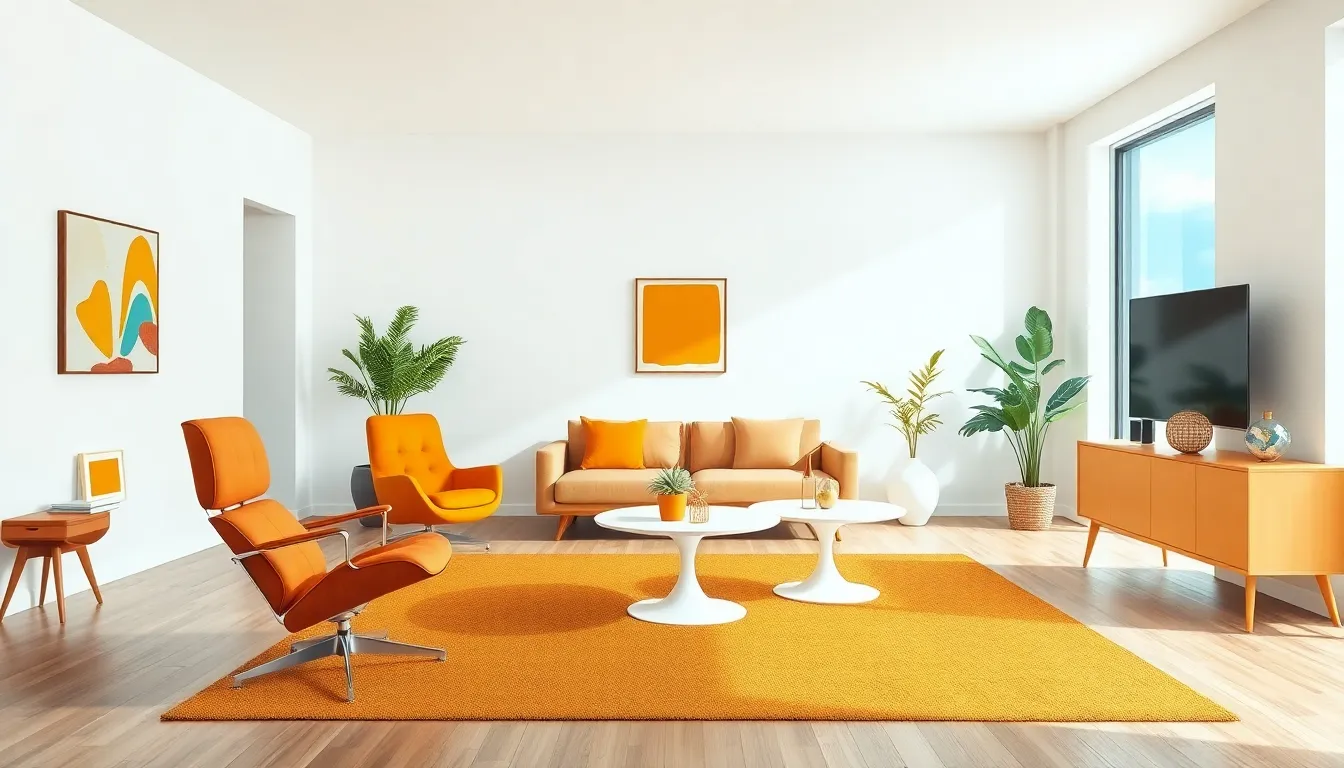Mid-century modern isn’t just a design style; it’s a lifestyle choice that whispers elegance while shouting, “Look at my fabulous furniture!” Emerging in the 1940s and peaking in the 1960s, this movement transformed homes into artistic sanctuaries with sleek lines and organic forms. Think of it as the love child of minimalism and retro flair, where function meets fabulousness.
Table of Contents
ToggleOverview of Mid-Century Modern
Mid-century modern design captures a distinctive style that emerged in the 1940s and flourished throughout the 1960s. This movement emphasizes simplicity and functionality while incorporating bold colors and innovative materials. Designers sought to create pieces that enhance living spaces through a harmonious blend of form and function.
Furniture from this period features clean lines and geometric silhouettes. Chairs, sofas, and tables often showcase a minimalistic approach, allowing space to feel open and inviting. Iconic examples, like the Eames Lounge Chair and the Saarinen Tulip Table, illustrate this philosophy beautifully.
Organic shapes also play a significant role. Designers frequently integrated curves and soft forms, contrasting the rigid lines of contemporary furniture. This balance of sharp and soft elements contributes to the aesthetic’s appeal.
The use of new materials, such as molded plastics, fiberglass, and plywood, revolutionized manufacturing processes. These advancements allowed for greater experimentation and enabled designers to push creative boundaries. The introduction of innovative techniques also led to more affordable and accessible pieces for the average consumer.
Mid-century modern aesthetics extend beyond furniture. Architecture reflects the same principles, with open floor plans and large windows inviting ample natural light. Homes from this era often display integration with nature, featuring expansive outdoor spaces like terraces and gardens.
Overall, mid-century modern represents a cultural movement that continues to influence design today. Its legacy is evident in contemporary interiors that embrace simplicity, functionality, and a seamless connection with the environment.
Key Characteristics

Mid-century modern design showcases distinct characteristics that define its aesthetic and functional qualities.
Design Elements
Design elements focus on clean lines and organic forms. Furniture often features geometric silhouettes, providing a striking contrast against softer shapes. Iconic pieces like the Eames Lounge Chair and Saarinen Tulip Table exemplify this blend of function and style. Minimalism governs the overall look, ensuring spaces feel open and uncluttered. Expansive use of space enhances flow and comfort, while the combination of materials promotes a varied texture. Designers prioritized practicality, developing multifunctional furniture ideal for diverse needs.
Color Palette
Bold colors play a pivotal role in mid-century modern aesthetics. Rich hues like orange, teal, and mustard yellow complement neutral tones. These colors create visual interest and enhance mood. Designers skillfully combined vibrant colors with earthy shades, establishing harmony within spaces. Accent pieces often capture attention through bright color choices, bringing personality to the room. Subtle pastels also appear, softening the overall palette and maintaining a balanced atmosphere. Each color choice brings depth, showcasing the thoughtful approach to aesthetic and experiential design.
Influential Designers
Several designers significantly shaped the mid-century modern movement, contributing unique creations that remain influential today.
Charles and Ray Eames
Charles and Ray Eames redefined furniture design through their innovative use of materials and functionality. Their Eames Lounge Chair exemplifies this approach, integrating comfort with elegance. They embraced molded plywood, fiberglass, and plastic, which allowed them to create iconic pieces such as the Eames Molded Plastic Chair. Collaboration between the couple fostered a unique design philosophy, balancing art with practicality. They revolutionized the concept of living spaces by advocating for furniture that supports the way people live, interact, and work.
George Nelson
George Nelson played a pivotal role in mid-century design, known for his ability to blend functionality and aesthetic appeal. He served as the design director for Herman Miller, where he created timeless pieces like the Marshmallow Sofa and the Bubble Lamp. Nelson’s work emphasized innovative use of space and form, promoting a modern yet inviting atmosphere. His designs reflect an understanding of human interaction, focusing on how people relate to their surroundings. As a writer and educator, he also spread the mid-century modern ethos, influencing countless designers to explore new possibilities within the field.
Iconic Mid-Century Modern Furniture
Mid-century modern furniture encompasses a range of distinctive, stylish designs that reflect the era’s emphasis on functionality and aesthetic appeal. This movement features a variety of iconic pieces, including seating and tables that have left a lasting impact on interior design.
Chairs and Seating
Chairs like the Eames Lounge Chair and the Hans Wegner Wishbone Chair exemplify mid-century seating. Each piece combines comfort and elegance, making them widely sought after. Notably, the Egg Chair by Arne Jacobsen showcases a sculptural form that invites relaxation while adding visual intrigue. Upholstered in rich fabrics, these chairs often incorporate organic shapes that seamlessly blend into living spaces. Designers prioritized ergonomics and style, ensuring that each chair enhances user experience and complements decor.
Tables and Storage
Tables such as the Saarinen Tulip Table redefine dining aesthetics with their smooth, streamlined forms. Their unique bases create an airy feel while accommodating various seating arrangements. Storage solutions in this period, including the celebrated George Nelson Storage Wall, utilize open shelving and closed cabinets to enhance practicality. Mid-century tables and storage often highlight natural wood grains, adding warmth to interiors. Minimalist designs prioritize both style and functionality, ensuring these pieces remain relevant and admired in contemporary homes.
Impact on Contemporary Design
Mid-century modern design profoundly influences contemporary design sensibilities. Today’s interiors often reflect the clean lines and organic forms emblematic of this movement. Designers incorporate mid-century elements to create spaces that prioritize both aesthetics and functionality. In particular, the open floor plans and large windows characteristic of this style enhance light and connectivity with the outdoors.
Furniture retains the iconic geometric silhouettes found in mid-century pieces. For example, the Eames Lounge Chair and Saarinen Tulip Table remain staples in modern living environments. Utilizing molded plastics and fiberglass, manufacturers today mirror the innovative use of materials that defined mid-century design. This approach permits greater experimentation while ensuring streamlined forms remain prominent in furniture collections.
Color palettes continue to take cues from mid-century modern. Bold hues like teal, orange, and mustard yellow, complemented by earth tones, create visual interest in contemporary spaces. Subtle pastels often soften designs, resulting in balanced atmospheres that echo that original aesthetic simplicity.
Posters, art prints, and textiles frequently feature mid-century motifs, reinforcing the movement’s continued relevance. Designers blend these elements seamlessly, cultivating a nostalgic yet fresh appeal. Multifunctional furniture, inspired by mid-century practicality, caters to modern lifestyles while maintaining a timeless quality, an essential aspect of contemporary design.
The legacy of influential figures like Charles and Ray Eames, George Nelson, and Arne Jacobsen persists into present-day practices. Their pioneering concepts resonate with today’s designers, fostering an appreciation for artistry alongside utility. Overall, mid-century modern design lives on, shaping the way individuals interact with their environments and enhancing everyday living.
Mid-century modern design remains a timeless influence that shapes contemporary living spaces. Its blend of functionality and aesthetic appeal continues to resonate with designers and homeowners alike. The movement’s emphasis on clean lines organic forms and vibrant colors creates environments that feel both inviting and stylish.
As individuals seek to create harmonious living spaces that reflect their lifestyles mid-century modern principles offer a blueprint for achieving that balance. The legacy of iconic designers and their innovative approaches ensures that this design philosophy will endure inspiring future generations to embrace simplicity and creativity in their homes.




